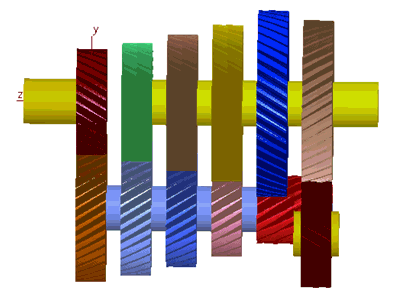 |
|
||||||||||||||||||||||||||||||||||
|
|||||||||||||||||||||||||||||||||||
Project Description
In many applications in mechanical engineering, gear wheels are used to transmit power between rotating shafts and, therefore, the ability to incorporate them into multibody systems and to simulate contact between them, has become an essential topic in multibody dynamics. The module SIMPACK (a software for analysis and design of general mechanical systems) engine offers a force element between rigid gear wheels in order to simulate contact between them [1]. This force element takes the geometry and position of meshing gears as input and calculates forces and moments acting on gear wheels. In this implementation, all of the geometric features of the involute tooth are considered. Since in real applications, gear wheels are not rigid and even due to the effect of contact forces, there exist some deformation in meshing teeth, therefore, it is reasonable to introduce elasticities in the model of meshing gear wheels. The FEM is without doubt the most powerful numerical method in the field of contact modeling and is suitable for particularly high requirements of accuracy but its very high computational effort, and specially for contact modeling of gear wheels, causes some practical difficulties in the contact modeling of many mechanical systems. Therefore, in this work, elastic elements between the teeth and the body of each gear wheel are considered. This approach can be specially suitable for multibody systems since it is a compromise between the totally rigid model and fully elastic model (FEM). In other words, the teeth and the body of each gear wheel are still rigid but they are connected to each other by elastic elements. In doing so, a precise algorithm is utilized to find the effect of multi-tooth contact as well as backlash and left and right-hand side contact of the meshing teeth. [1] L. Mauer: Force Element 225 Gear Wheel, Internal report, Intec GmbH, Wessling, Germany, 2005. Related PagesContact |
| Last modified
3.9.2013 ( |

